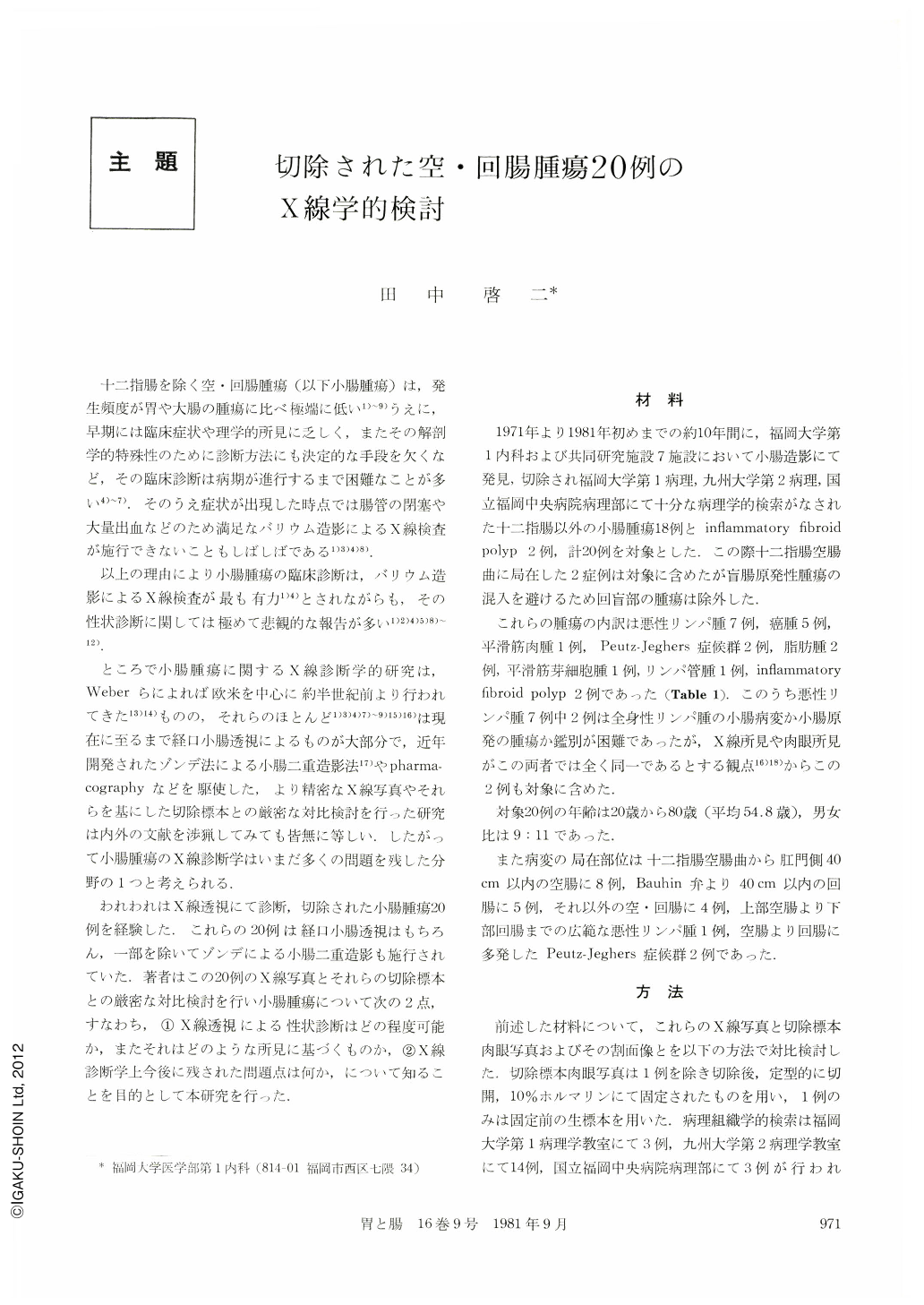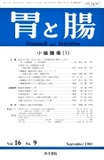Japanese
English
- 有料閲覧
- Abstract 文献概要
- 1ページ目 Look Inside
- サイト内被引用 Cited by
十二指腸を除く空・回腸腫瘍(以下小腸腫瘍)は,発生頻度が胃や大腸の腫瘍に比べ極端に低い1)~9)うえに,早期には臨床症状や理学的所見に乏しく,またその解剖学的特殊性のために診断方法にも決定的な手段を欠くなど,その臨床診断は病期が進行するまで困難なことが多い4)~7).そのうえ症状が出現した時点では腸管の閉塞や大量出血などのため満足なバリウム造影によるX線検査が施行できないこともしばしばである1)3)4)8).
以上の理由により小腸腫瘍の臨床診断は,バリウム造影によるX線検査が最も有力1)4)とされながらも,その性状診断に関しては極めて悲観的な報告が多い1)2)4)5)8)~12)
Twenty cases of the tumors of the small intestine excluding the duodenum, diagnosed roentgenologically and verified histologically, were studied by comparing roentgenological characteristics of these tumors with their gross findings. Numbers of cases of carcinoma, malignant lymphoma, leiomyosarcoma, Peutz-Jeghers syndrome, lipoma, leiomyoblastoma, lymphangioma and inflammatory fibroid polyp were four, seven, one, two, two, one, one and two respectively. Age ranged from 20 to 80 years (mean 54.8years). Male female ratio was 9 to 11.
Results were as follows:
1. The tumors were diffuse or multiple in three cases and single in the other 17. Of the latter 17 cases, the tumor was located in the jejunum within 40cm anal to the ligament of Treitz in eight, in the ileum within 40cm oral to Bauhin's valve in five and in the intermediate portion in the other four.
2. Tumor in two cases of carcinoma was a short annular ulcerative lesion both macroscopically and roentgenologically. The outer boundary of the tumor was irregular and uneven. On the cut surface, tumor grew intraluminally compressing and overhanging the normal mucosa bordering the tumor. On roentgenograms, these features of carcinoma showed annular constriction with overhanging edges and irregular outlines. The appearance of the tumor was not changed by various degrees of distension by air and of compression at radiological examination and seemed rigid. This rigidity was suspected to be caused by marked fibrosis of the central part of the tumor.
In the other two cases of carcinoma, tumor was an annular ulcerative lesion without stenosis both macroscopically and roentgenologically. In one of them, tumor showed extraluminal growth on macroscopical and roentgenological examinations. On the cut surface, features of tumor growth towards the lumen and the surrounding tissue were similar to those of the annular constricting carcinomas, and showed overhanging edges in part and irregular margins had seemed rigid on roentgenograms. Carcinoma showing extraluminalg rowth had features of submucosal tumor in its anal part.
3. Tumors of five cases of malignant lymphoma showed annular and longitudinal growth: Protrudent lesions two; ulcerative lesions with the lumen slightly wider than normal intestine two; and ulcerative lesion with the lumen markedly wider than that of the normal intestine one. On the cut surface, peripheral part of the tumor was covered by the normal mucosa and bulged into the lumen. The boundary between the normal mucosa and the tumor tissue exposed to the lumen was smooth. Roentgenologic findings reflected these macroscopic features of this tumor.
Characteristic findings on roentgenograms were as follows: (1) mucosal destruction or tumor shadow, suggesting longitudinal growth of this tumor; (2) annular tumor with the lumen narrower or wider than that of the normal small intestine; (3) tumor shadows changing in shape by varied degrees of distension by air or of compression and suggesting a less rigid tumor; (4) the smooth boundary between tumor and the normal mucosa; (5) features of submucosal tumor at the peripheral borders of the tumor; and (6) compression effects of the intestinal loops adjacent to that harbouring the tumor.
Tumors of the other two cases of malignant lymphoma were as follows: very diffusely spreading and not localized tumor with small multiple shallow ulceralions one; and polypoid tumor causing intussusception one.
4. There are difficulties in the macroscopic classification of the small intestinal tumors. Definitions of the macroscopic types were vague, and classification has been made by appearances on the serosal and/or mucosal surfaces and frequently by the resected specimen which was opened longitudinally making its features in three dimensions vague.
It seems necessary to reevaluate macroscopic findings of the tumors of the small intestine and to classify them by more precise and rigid criteria. Resected specimens should be fixed before opening the lumen and ingating them with formalin solution.
5. All of the benign tumors of the eight cases were polypoid, and four of them showed findings of intussusception at roentgenological examination.
6. Two lipomas had very smooth surface and stalk, and changed in shape considerably by compression at barium meal study.

Copyright © 1981, Igaku-Shoin Ltd. All rights reserved.


